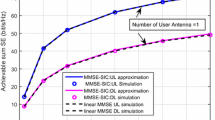Abstract
In this paper, we analyze the capacity of multiple-input multiple-output systems employing maximal ratio combining under Rayleigh fading environments in the presence of spatial fading correlation at the transmitter or receiver. Based on statistical properties of the largest eigenvalue of correlated complex Wishart matrices, the exact closed-form expressions for the cumulative distribution function and the probability density function of the output signal-to-noise ratio are presented. The results are used to analyze the outage and ergodic capacities of the systems. The analysis shows that ergodic capacity improves with the increase of the channel correlation coefficient and the analytical results are validated by Monte Carlo simulations.
Similar content being viewed by others
References
Foschini G. J., Gans M. J. (1998). On limits of wireless communications in a fading environment when using multiple antennas. Wireless Personal Communications 6(3):311–335
Telatar E. (1999). Capacity of multi-antenna Gaussian channels. European Transactions on Telecommunications 10(6):585–595
Lo T. K. T. (1999). Maximum ratio transmission. IEEE Transactions on Communications 47(10):1458–1461
Dighe P. A., Mallik R. K., Jamuar S. S. (2003). Analysis of transmit-receive diversity in Rayleigh fading. IEEE Transactions on Communications 51(4):694–703
Kang M., Alouini M. S. (2004). A comparative study on the performance of MIMO MRC systems with and without cochannel interference. IEEE Transactions on Communications 52(8):1417–1425
Chen Y., Tellambura C. (2005). Performance analysis of maximal ratio transmission with imperfect channel estimation. IEEE Communications Letters 9(4):322–324
Maaref A., Aïssa S. (2005). Closed-form expressions for the outage and ergodic Shannon capacity of MIMO MRC systems. IEEE Transactions on Communications 53(7):1092–1095
Kang, M., & Alouini, M. S. (2003). Impact of correlation on the capacity of MIMO Channels. In Proc. IEEE Int. Conf. Commun. (ICC) (pp. 2623–2627). Anchorage, AK.
Zanella, A., Chiani, M., & Win, M. Z. (2005). Performance of MIMO MRC in correlated Rayleigh fading environments. In Proc. IEEE Veh. Tech. Conf. (VTC) (pp. 1633–1637). Stockholm, Sweden.
Gradshteyn, I. S., & Ryzhik, I. M. (2000). Table of integrals, series, and products (6th ed). San Diego, CA: Academic.
Golberg M. A. (1972). The derivative of a determinant. American Mathematical, Monthly 79(10):1124–1126
Alouini M. S., Goldsmith A. J. (1999). Capacity of Rayleigh fading channels under different adaptive transmission and diversity-combing techniques. IEEE Transactions on Vehicular Technology 48(4):1165–1181
Author information
Authors and Affiliations
Corresponding author
Rights and permissions
About this article
Cite this article
Rui, X., Jin, R. & Geng, J. Capacity analysis of MIMO MRC systems in correlated rayleigh fading environments. Wireless Pers Commun 43, 1569–1576 (2007). https://doi.org/10.1007/s11277-007-9327-7
Received:
Accepted:
Published:
Issue Date:
DOI: https://doi.org/10.1007/s11277-007-9327-7




